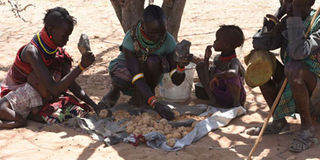Bold strategies needed to tackle Kenya’s cyclic hunger challenge

Residents of Turkana South prepare to cook wild fruits on March 23, 2019 as hunger bites. PHOTO | JARED NYATAYA | NATION MEDIA GROUP
What you need to know:
- Looking at this chain of unfortunate events, there is plenty to suggest that Kenya should employ bolder and more effective strategies to tackle the food security challenge.
- The Youth and Uwezo funds ought to be made more easily accessible to young farmers to buy quality farm inputs and lease land from their parents.
Last week, the nation was confronted with the shocking news that the Kenya Plant Health Inspectorate Service (Kephis) rejected 221 of 282 tonnes of potato seed shipped into the county for multiplication ahead of this year’s planting season after they were found to be infected by a harmful bacterial disease.
Shortage of high quality seed could translate to lower production of potatoes, Kenya’s second most popular starch after maize.
And this while 13 counties have been severely hit by drought and require immediate intervention to prevent widespread starvation.
Looking at this chain of unfortunate events, there is plenty to suggest that Kenya should employ bolder and more effective strategies to tackle the food security challenge.
AGRICULTURE
To be fair, there is some impressive work that has started taking place.
A good example is the newly-launched Potato Seed Production Unit at Tumaini National Youth Service, in Nyandarua County, with the capacity of producing 9,000 tonnes of seedlings annually.
The plant is using aeroponics technology — a rapid seed multiplication technique for producing potato seed with a yield of up to 10 times higher than the traditional method.
It’s initiatives such as these that make one wonder why similar high-impact agricultural projects are not being rolled out across all the other counties.
Part of this could be attributed to the fact that, while agricultural extension services have been devolved, agricultural research has largely remained a preserve of the national government, in Nairobi.
The missing link therefore lies in leveraging universities, particularly those with established agriculture departments, with the objective of developing a deep understanding of the local conditions at the county level and prescribing the most effective projects that would have the maximum impact on the local community.
LAND-GRANT
But for this model to succeed, universities will need to have access to regular funding and might need to consider the land-grant model, which is extremely successful in the United States.
Land-grant universities were conceived in America to cater for the need to teach practical agricultural, military science and engineering courses in response to the Industrial Revolution.
Through various legislations known as the Morrill Acts came the funding of educational institutions that would be granted federally controlled land, which they would sell and raise funds to establish an endowment to consistently earn interest income to fund research.
Institutions that thrived on this model include Cornell University and the Massachusetts Institute of Technology.
A second bold strategy would be increasing the number of youth engaged in agriculture.
YOUTH
Given that the average Kenyan farmer is above 60 years, there needs to be a serious push towards mentoring a new generation of food producers.
Agriculture was considered a low-quality profession, meant for the lowly educated. But now, there is genuine sophistication introduced to the practice of farming that has made it quite attractive to youth.
The main factors preventing more youth from venturing into agriculture is limited access to finance and lack of land.
The Youth and Uwezo funds ought to be made more easily accessible to young farmers to buy quality farm inputs and lease land from their parents, who may be about to retire and need extra income.
Kenya can draw inspiration from the smaller nation of Ireland, which has a population of only five million but produces food for 50 million people.
With bold strategies, we have the rare opportunity to launch a pan-African food revolution that will change the narrative of a continent personified by a begging bowl to one with the capacity to feed the world.
Mr Gichinga is the chief economist at Mentoria Economics. @kgichinga




